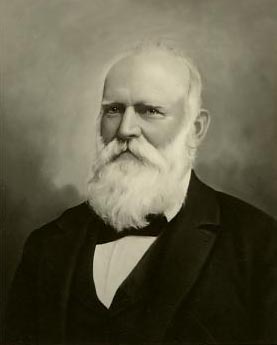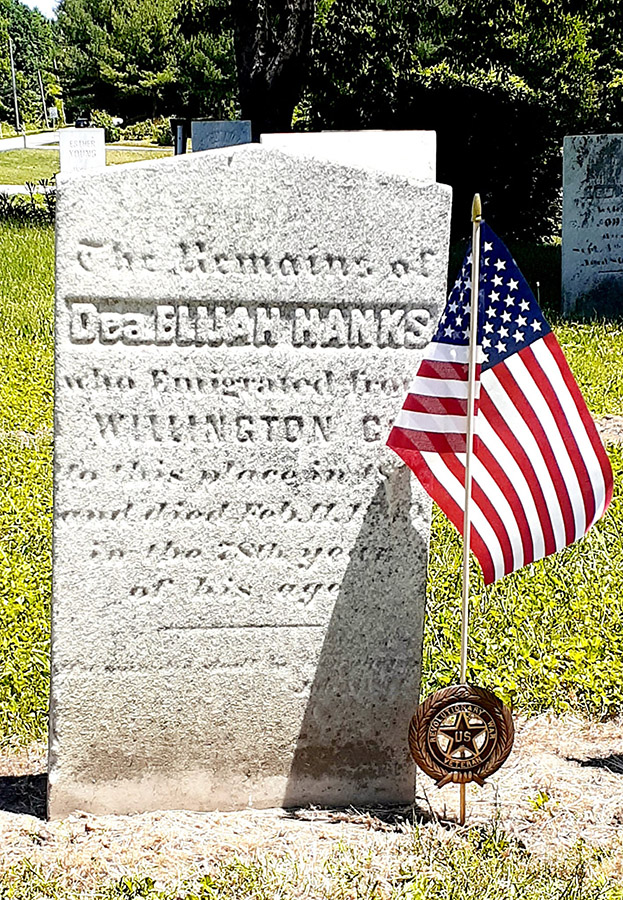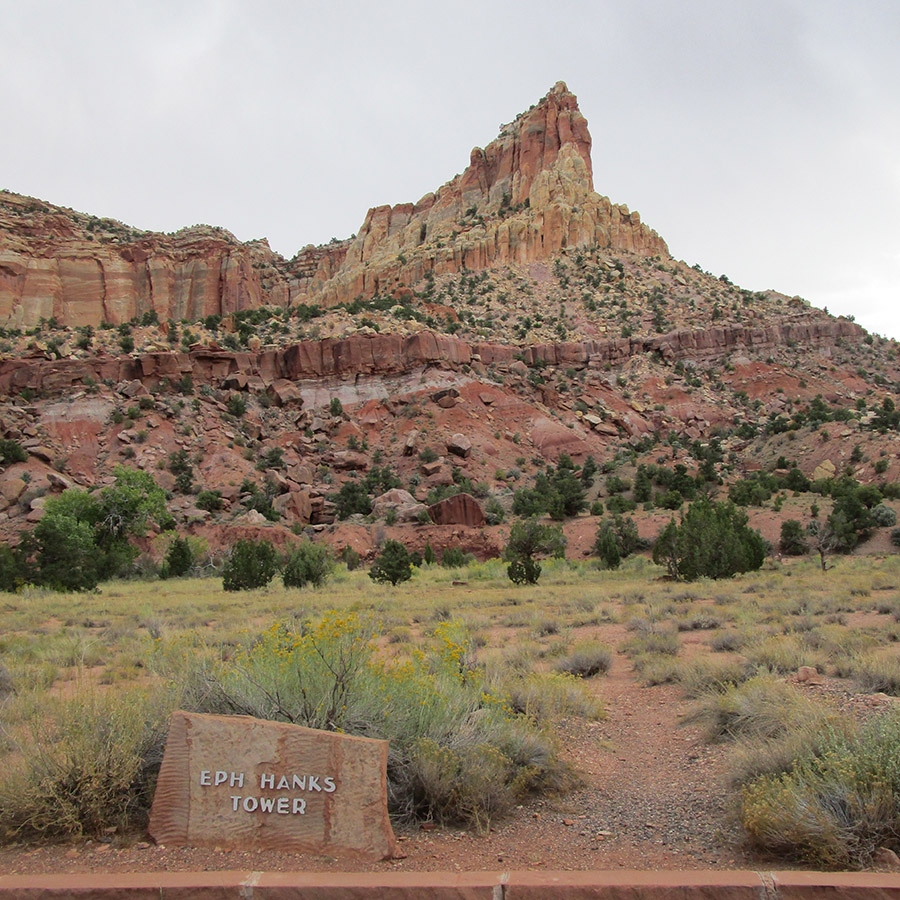

On a trip to Capitol Reef National Park in Utah, one of the features I photographed was a formation called ‘Eph Hanks Tower.’ The tower was an outcrop of red and rose-colored sandstone that rose to a height of 6,500 feet above sea level; 900 feet above the desert floor. I wondered who is Eph Hanks, and why does he get a tower named after him? A little research led to a lot of information about the man and the tower. It is named after Ephraim Knowlton Hanks, a Mormon pioneer and first permanent white settler in the Capitol Reef area, who with his family homesteaded in the Pleasant Creek Area of Capitol Reef in 1881. And most interesting, Eph Hanks was born in Madison, Ohio!
The Hanks family arrived in Madison in 1811. The head of the family was Deacon Elijah Hanks, who was born in Mansfield CT in 1761. Elijah was the seventh of their thirteen children, and enlisted in Revolutionary War service in 1778, serving in the “Connecticut Line” in the 3rd Connecticut Regiment. In 1782 Elijah married Mary Walker, and their nine children were born and raised in Wellington. On September 9th 1811, the family left Connecticut for Ohio, and arrived in Madison October 3rd. They immediately began building a log home on what is now South Ridge Road, moving in on November 8th. Hanks was well esteemed by his neighbors, made his living as a farmer, and offered shelter to many settlers new to Madison until their homes could be built. Elijah Hanks died in 1839, and Mary died in 1844. Both are buried near the Hanks homestead, in the South Ridge Cemetery in Madison.

Benjamin Hanks was the fourth of nine children born to Elijah and Mary Hanks. Born in 1788, he was 23 years old when he moved with his family to Madison. He married Martha Knowlton of Connecticut in September 1811, shortly before the move. Benjamin and Martha had twelve children, all born on the Hanks homestead in Madison. The homestead passed to Benjamin after Elijah died; and by that time, a fine, large home occupied the property on South Ridge Road. Benjamin was a blacksmith by trade, as well as a farmer. He died in 1843, and Mary passed away in 1861.
Ephraim Knowlton Hanks, ‘Eph,’ was born on March 21, 1826 at the family homestead in Madison, the 8th of Benjamin and Mary’s 12 children. He left home at age 16 and worked for a time on the Erie Canal, then served in the U.S. Navy on board the USS Columbus. In 1845, after leaving the Navy, he returned home to Madison where his brother Alvarus, a Mormon missionary, was visiting. After lengthy discussion with his brother about the Mormon faith, Eph decided to become a member of the Mormon Church, and follow Alvarus to Nauvoo Illinois.

Eph left Nauvoo with Latter Day Saints followers of Brigham Young on a journey west. He left the main body of emigrants to join Company B of the Mormon Battalion, United States Army, and marched with the Army to San Diego California. After his release from Army service, he traveled with Mormon emigrants going from California to the Salt Lake area in Utah, and joined a Mormon militia there. In 1849, 30 Mormon families moved to settle the Utah Valley, in what was historically a Timpanogos Tribal settlement, sacred area, and hunting/fishing territory. The following year Governor Brigham Young granted a war order to the militia, allowing them to exterminate the Timpanogos Tribe, with orders to kill all the tribe’s men and save the women and children that behaved. Eph was part of a smaller group of 16 men who made a charge on a Timpanogos log house where multiple families tried to defend themselves; and they successfully took the log house. The Timpanogos retreated and the militia was able to pursue and kill around 100 members of the tribe.
Eph Hanks was instrumental in the rescue of the Martin Handcart Company; where a group of Mormon emigrants from Europe, en route to Utah, had become stranded by heavy snows and extreme cold in central Wyoming in 1856. He provided protein rich buffalo meat to the starving party, spiritual enrichment to disconsolate travelers, and helped with amputations to stop the progression of frostbite and gangrene that plagued the group. By his own account, Hanks helped on two occasions to raise the dead, and with his faith helped heal the sick. Altogether the Martin Handcart Company lost over 145 emigrants to starvation, sickness, and severe weather, before they reached Salt Lake City.

Eph was ordained a Patriarch in the LDS Church, and was known for his obedience to church leaders. He practiced plural marriage, having 4 wives and 26 children. Hanks married Harriet Decker in 1848, Hannah Hardy in 1856, Jane Capener in 1856, and Thisbe Read in 1862. Thisbe was a survivor of the Martin Handcart Company. He divorced both Harriet and Jane at a later date and annulled the marriage to Hannah late in 1856. In 1883 Eph Hanks, Thisbe and their 12 children were the first permanent settlers in the Pleasant Creek area of what is now Capitol Reef National Park, Utah. Initially the family lived in three ‘Hanks Dugouts,’ relatively easy and inexpensive hand-dug structures made of dirt, rocks, and logs. By 1888, the family had constructed a permanent four room wood frame house called Floral Ranch and abandoned the dugouts. The wood frame house near the dugouts burned down in 1945, and the ‘Hanks Dugouts’ site was placed on the National Register of Historic Places in 1999.
Eph Hanks died in his Pleasant Creek home in 1896, at age 70. According to his many biographies and his obituary, he was a man of strong faith with a willingness to serve his church. He was ordained a Seventy within the Mormon Church; appointed a High Priest by third president of the Mormon Church John Taylor; and ordained a Patriarch by Apostle Brigham Young.
In 1930, after 119 years, the Hanks Homestead on South Ridge Road in Madison quietly went out of family ownership. The home still stands today, in view of the South Ridge Cemetery where so many of the Hanks family are buried.
Submitted by Jesse Devin, Social Media Assistant Madison Historical Society
Madison Historical Society Executive Board & Advisors
Cheryl Swackhamer – President
Dianne Cross – Vice President
Donald Bartlett – Secretary
Michael Gehring – Treasurer / Business Manager
Marjorie Shook – Office Manager / Membership Chair
Sherry Carsey – Curator
Sue Lampey – Research Chair
John Vohlidka – Newsletter Editor
Trevor Behm – Advisor
Richard Collins Jr. – Advisor
Ned Foley – Advisor
David Van Dusen – Advisor
Shane Oravetz – Advisor
Carrie Svigel – Advisor
The Madison Historical Society is a 501(c)3 corporation, and most donations have tax advantages. You can support MHS through making a donation, shopping with Amazon Smile, a tax-free IRA Contribution, or a gift of Stock.
To make a General donation, Memorial donation, or Capital Fund Drive donation to the Madison Historical Society, please complete the form below and make a payment via PayPal using your credit card or PayPal account. If you prefer to send a check, please make it payable to Madison Historical Society and send to PO Box 515, Madison, OH 44057.
Volunteers created the Madison Historical Society in 1978, and have been essential to the success of our organization! We are always looking for people to help with a variety of activities that keep the society running smoothly. Why not share your enthusiasm, creativity, and talent with us?